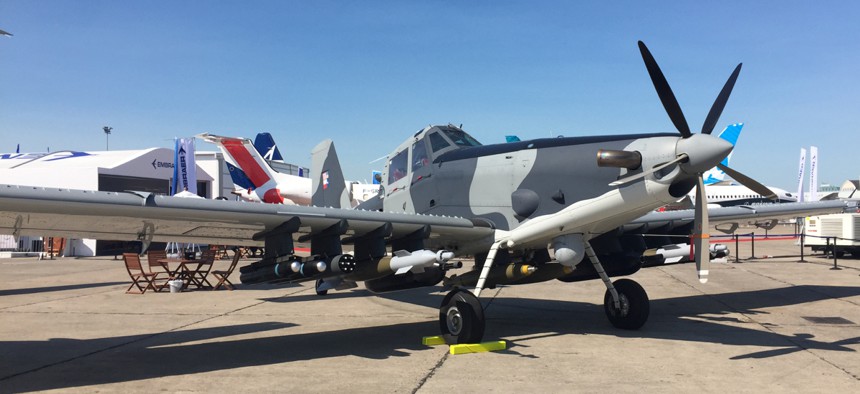
An L3 Longsword attack plane at the 2017 Paris Air Show. L3 Technologies and Harris announced on Oct. 14 that they plan to merge by mid-2019. L3 Technologies
L3, Harris CEOs: Merger Will Help Compete Against Top Contractors
L3 expects to depart its Manhattan headquarters and join Harris in Florida.
What started as a social relationship between L3 Technologies CEO Chris Kubasik and Harris CEO Bill Brown led to Sunday’s announcement that the two firms intend to merge, creating a new $16 billion aerospace company that would be one of the largest defense contractors in America.
Brown, in a joint interview with Kubasik on Sunday, said talks between Harris and L3 began earlier this year, but “really picked up steam in the summer.” The executives expect the deal to close in mid-2019, if the government approves.
“We realized, given where we stack up in the defense hierarchy, this would be a great potential combination,” Brown said.
L3 will shrink or close its midtown Manhattan headquarters and move to Harris' home base in Melbourne, Florida, where the merged entity will be called L3 Harris Technologies.
Related: Foreign Weapons Get a Closer Look as the Pentagon Races to Rearm
Related: Why 386 Squadrons? Air Force Says It’ll Have the Data Next Year
Related: Trump Wants Chinese Parts Out of American Weapons
“We'll be transitioning from the headquarters from New York and taking the best of the best and moving to Florida,” Kubasik said. “The short answer is: at some point the Manhattan office will either be significantly scaled down or ultimately closed.”
Harris’ Brown is expected to become chairman and CEO of the new L3 Harris. Kubasik, who took over as L3's CEO only last January, will be president and COO. Two years after the deal’s closing, Kubasik is expected to be named CEO. A year after that, he is expected to add chairman to his title.
Based on 2017 revenue, L3 Harris would be the world’s seventh-largest defense firm, and the sixth-largest U.S. defense firm, according to the latest Defense News Top 100 rankings.
“[T]here are not a lot of major overlaps between Harris and L3,” said Byron Callan of Capital Alpha Partners, in a note to investors after the Wall Street Journal reported the merger on Saturday.
Callan noted that both companies have night vision and data-links businesses. Asked Sunday about overlapping sectors or possible divestitures, Brown said the companies have “very high and complementary portfolios. So we see very, very, very little overlap.”
Those portfolios are incredibly diverse. L3 is a major supplier of electronics and intelligence equipment for the Pentagon, everything from military training to special operations aviation software, submarine radar and sensors, ship-board targeting systems, and more. It also builds airport security systems. Harris supplies the Pentagon with tactical radios, satellite payloads, and electronic-warfare gear. It’s a major player in the FAA’s air traffic control modernization effort.
Kubasik had been looking to elevate L3’s profile though mergers and acquisitions. The company has had a keen interest in underwater drone technology, making a number of acquisitions over the past two-plus years. He said those acquisitions would slow in the wake of the Harris merger.
Related: Defense One’s live Global Business Briefing with former L3 CEO Michael T. Strianese
“Job one is going to be the integration for the first couple years, so there will be very, very few, if any, acquisitions,” he said Sunday. “They would have to be a once in a lifetime opportunity.”
A former senior defense official said the merger represents further consolidation in the defense industry’s second tier, a trend that the Pentagon watches closely.
Brown said the companies alerted their U.S. government customers of the merger on Saturday.
“Initial reaction, I think, was positive,” he said.




